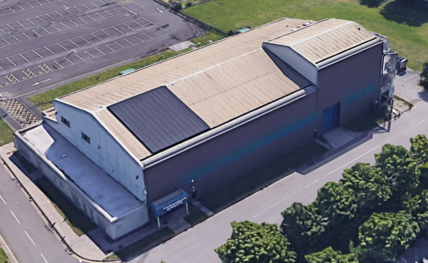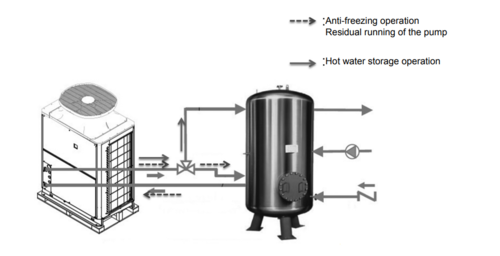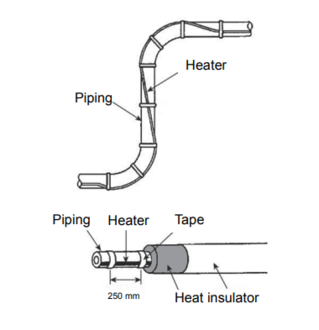To Do:
- Review designs and calculate loads
- Produce schematic of proposed design
- Detailed design of pipework and equipment
Aims
The aim of the project is two-fold.
- Provide better heating for the building using low carbon heat, bringing the building up to a suitable level of heating to be passed on to the next occupants.
- Conduct detailed tests to work out the best practices and installation choices, to maximise in-use efficiency of CO2 heat pump technology, and work out it's place in the renewables landscape for the future.
Requirements
Following initial site meetings the following requirements have been set:
- Installation of CO2 air source heat pump(s)
- Low use domestic hot water
- Central heating to 10 office spaces
- Office spaces to be fitted with a selection of heat emitter types
- System to be flexible enough to allow different heating strategies to be tested
- System must be of a standard to be handed over to the next building occupants
- System must allow for the optional use of fan convectors as final stage to heat the main area and lower return temperatures
- System to be provide real-time operational data and allow details adjustment of settings and controls logic
Documents


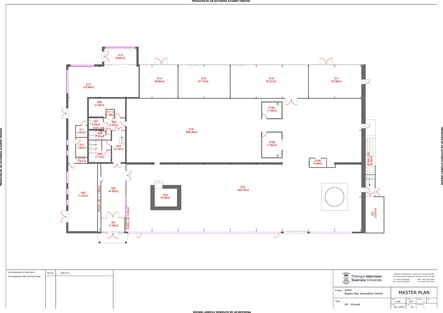



Design Points
The following points have been considered.
QAVH connection to buffer store. This arrangement is used to draw heat from the cold part of the buffer for defrost protection.
Setting 121 decides secondary control is enabled. We do not need secondary control so it can be left in default setting (off).
Trace heating (electrical tape) is used to prevent pipework from freezing as a matter of last resort if the circulation pump should fail for defrosting. We will tie control over this into system.
Because of the need for (1) the heat pump defrost circuit to go through the store, and (2) the stability of the output from the heat pump is unknown and could do with some buffering via the top of the buffer store, it will be prudent to fit buffer stores with internal diffuser plates to create chambers to contain turbulence, and maintain stratification.
This table shows water quality requirements for the heat pump, and also for a secondary side (not used in SHED). It is important that regular tests are made to ensure this is met. It is also advisable to install water filtration equipment that can maintain these parameters with as little maintenance as possible. Remote monitoring on each of these would be nice.
System Schematic
- Double-click in the diagram background in order to add a new node there.
- Add ports to a selected node by clicking the above buttons or by using the context menu.
- Draw links between ports by dragging between ports.
- Right-click on a port to bring up menu.
{ "class": "GraphLinksModel",
"copiesArrays": true,
"copiesArrayObjects": true,
"linkFromPortIdProperty": "fromPort",
"linkToPortIdProperty": "toPort",
"nodeDataArray": [
{"key":"CYL1","name":"Buffer Store","loc":"-58.57496475070138 191.3160717356572","leftArray":[{"portColor":"#ff0000","portId":"left0"},{"portColor":"#ff0000","portId":"left1"},{"portId":"left2","portColor":"#ff0000"},{"portId":"left3","portColor":"#ff0000"},{"portId":"left4","portColor":"#ff0000"},{"portId":"left5","portColor":"#ff0000"},{"portId":"left6","portColor":"#ff0000"},{"portId":"left7","portColor":"#e39f35"},{"portId":"left8","portColor":"#e39f35"},{"portId":"left9","portColor":"#e39f35"},{"portId":"left10","portColor":"#fbe264"},{"portId":"left11","portColor":"#fbe264"},{"portId":"left12","portColor":"#fbe264"},{"portId":"left13","portColor":"#ffff00"},{"portId":"left14","portColor":"#ffff00"},{"portId":"left15","portColor":"#ffff00"},{"portId":"left16","portColor":"#8bc34a"},{"portId":"left17","portColor":"#8bc34a"},{"portId":"left18","portColor":"#2196f3"},{"portId":"left19","portColor":"#2196f3"}],"topArray":[{"portColor":"#ffffff","portId":"top0"},{"portId":"top1","portColor":"#ffffff"},{"portId":"top2","portColor":"#ffffff"},{"portId":"top3","portColor":"#ffffff"},{"portId":"top4","portColor":"#ffffff"},{"portId":"top5","portColor":"#ff0000"},{"portId":"top6","portColor":"#ffffff"},{"portId":"top7","portColor":"#ffffff"},{"portId":"top8","portColor":"#ffffff"},{"portId":"top9","portColor":"#ffffff"},{"portId":"top10","portColor":"#ffffff"}],"bottomArray":[],"rightArray":[{"portColor":"#ff0000","portId":"right0"},{"portColor":"#ff0000","portId":"right1"},{"portId":"right2","portColor":"#ff0000"},{"portId":"right3","portColor":"#ff0000"},{"portId":"right4","portColor":"#ff0000"},{"portId":"right5","portColor":"#ff0000"},{"portId":"right6","portColor":"#ff0000"},{"portId":"right7","portColor":"#e39f35"},{"portId":"right8","portColor":"#e39f35"},{"portId":"right9","portColor":"#e39f35"},{"portId":"right10","portColor":"#fbe264"},{"portId":"right11","portColor":"#fbe264"},{"portId":"right12","portColor":"#fbe264"},{"portId":"right13","portColor":"#ffff00"},{"portId":"right14","portColor":"#ffff00"},{"portId":"right15","portColor":"#ffff00"},{"portId":"right16","portColor":"#8bc34a"},{"portId":"right17","portColor":"#8bc34a"},{"portId":"right18","portColor":"#2196f3"},{"portId":"right19","portColor":"#2196f3"}],"notes":"500 litre"},
{"name":"Loading\nValve","leftArray":[{"portId":"left0","portColor":"#f6beb6"}],"rightArray":[{"portId":"right0","portColor":"#f6beb6"}],"topArray":[],"bottomArray":[{"portId":"bottom0","portColor":"#addff9"}],"key":"loadV","loc":"-295.11505660615677 -46.95580347636087"},
{"name":"Expansion\nVessel","leftArray":[],"rightArray":[],"topArray":[{"portId":"top0","portColor":"#ffffff"},{"portId":"top1","portColor":"#ffffff"},{"portId":"top2","portColor":"#ffffff"},{"portId":"top3","portColor":"#ffffff"},{"portId":"top4","portColor":"#ffffff"},{"portId":"top6","portColor":"#ffffff"},{"portId":"top7","portColor":"#ffffff"},{"portId":"top8","portColor":"#ffffff"}],"bottomArray":[{"portId":"bottom0","portColor":"#6cafdb"}],"key":"expVessel1","loc":"-378.7420000000001 313.43512499999997"},
{"name":"Radiators","leftArray":[{"portId":"left0","portColor":"#ffffff"},{"portId":"left1","portColor":"#ffffff"},{"portId":"left2","portColor":"#ffffff"},{"portId":"left3","portColor":"#ffffff"},{"portId":"left4","portColor":"#fae3d7"}],"rightArray":[{"portId":"right0","portColor":"#ffffff"},{"portId":"right1","portColor":"#ffffff"},{"portId":"right2","portColor":"#ffffff"},{"portId":"right3","portColor":"#ffffff"},{"portId":"right4","portColor":"#6cafdb"}],"topArray":[],"bottomArray":[],"key":"radsUp","loc":"439.68467048710613 108.33087392550146"},
{"name":"Pump","leftArray":[{"portId":"left0","portColor":"#fae3d7"}],"rightArray":[{"portId":"right4","portColor":"#fae3d7"}],"topArray":[],"bottomArray":[],"key":"pump1","loc":"225 11.125","notes":"Magna 3"},
{"name":"Radiators","leftArray":[{"portId":"left0","portColor":"#ffffff"},{"portId":"left1","portColor":"#ffffff"},{"portId":"left2","portColor":"#ffffff"},{"portId":"left3","portColor":"#ffffff"},{"portId":"left4","portColor":"#fae3d7"}],"rightArray":[{"portId":"right0","portColor":"#ffffff"},{"portId":"right1","portColor":"#ffffff"},{"portId":"right2","portColor":"#ffffff"},{"portId":"right3","portColor":"#ffffff"},{"portId":"right4","portColor":"#66d6d1"}],"topArray":[],"bottomArray":[],"key":"radsDown","loc":"442 187.125"},
{"name":"Pump","leftArray":[{"portId":"left0","portColor":"#f6beb6"}],"rightArray":[{"portId":"right4","portColor":"#40aceb"}],"topArray":[],"bottomArray":[],"key":"pumpB","loc":"-410 123.125","notes":"Integral to heat pump"},
{"name":"40kW Air-Source\nCO2 Heat Pump","leftArray":[],"rightArray":[{"portId":"right0","portColor":"#f6beb6"},{"portId":"right1","portColor":"#66d6d1"}],"topArray":[],"bottomArray":[],"key":"HP1","loc":"-696.7532829862678 -0.33269295923378195","notes":"Mitsubishi Electric QAHV"},
{"name":"DHW\nHIU","leftArray":[],"rightArray":[],"topArray":[{"portId":"top0","portColor":"#fadfe5"},{"portId":"top1","portColor":"#f6beb6"}],"bottomArray":[{"portId":"bottom0","portColor":"#d6effc"},{"portId":"bottom1","portColor":"#6cafdb"}],"key":"HIU1","loc":"546.8540219357686 -16.8675790015337","notes":"SLIM HIU"},
{"name":"Taps","leftArray":[{"portId":"left0","portColor":"#f6beb6"}],"rightArray":[{"portId":"right0","portColor":"#ffffff"}],"topArray":[],"bottomArray":[],"key":"DHW","loc":"656.9815186246419 -71.55967048710599"},
{"name":"Mains","leftArray":[{"portId":"left0","portColor":"#40aceb"}],"rightArray":[{"portId":"right0","portColor":"#ffffff"}],"topArray":[],"bottomArray":[],"key":"CWS","loc":"658.2989961081664 6.78275827275742"},
{"name":"Unit","leftArray":[{"portId":"left0","portColor":"#addff9"}],"rightArray":[],"topArray":[{"portId":"top0","portColor":"#addff9"}],"bottomArray":[{"portId":"bottom0","portColor":"#f6beb6"}],"key":"fanValve1","loc":"617 285.6875"},
{"name":"H/C\nMeter","leftArray":[],"rightArray":[],"topArray":[{"portId":"top0","portColor":"#f6beb6"}],"bottomArray":[{"portId":"bottom0","portColor":"#40aceb"}],"key":"HM1","loc":"-498 75.6875"},
{"key":"CYL2","name":"Buffer \ntore","loc":"111.42503524929862 192.3160717356572","leftArray":[{"portColor":"#ff0000","portId":"left0"},{"portColor":"#ff0000","portId":"left1"},{"portId":"left2","portColor":"#ff0000"},{"portId":"left3","portColor":"#ff0000"},{"portId":"left4","portColor":"#ff0000"},{"portId":"left5","portColor":"#ff0000"},{"portId":"left6","portColor":"#ff0000"},{"portId":"left7","portColor":"#e39f35"},{"portId":"left8","portColor":"#e39f35"},{"portId":"left9","portColor":"#e39f35"},{"portId":"left10","portColor":"#fbe264"},{"portId":"left11","portColor":"#fbe264"},{"portId":"left12","portColor":"#fbe264"},{"portId":"left13","portColor":"#ffff00"},{"portId":"left14","portColor":"#ffff00"},{"portId":"left15","portColor":"#ffff00"},{"portId":"left16","portColor":"#8bc34a"},{"portId":"left17","portColor":"#8bc34a"},{"portId":"left18","portColor":"#2196f3"},{"portId":"left19","portColor":"#2196f3"}],"topArray":[{"portColor":"#ffffff","portId":"top0"},{"portId":"top4","portColor":"#ffffff"},{"portId":"top5","portColor":"#ff0000"},{"portId":"top6","portColor":"#ffffff"},{"portId":"top7","portColor":"#ffffff"}],"bottomArray":[],"rightArray":[{"portColor":"#ff0000","portId":"right0"},{"portColor":"#ff0000","portId":"right1"},{"portId":"right2","portColor":"#ff0000"},{"portId":"right3","portColor":"#ff0000"},{"portId":"right4","portColor":"#ff0000"},{"portId":"right5","portColor":"#ff0000"},{"portId":"right6","portColor":"#ff0000"},{"portId":"right7","portColor":"#e39f35"},{"portId":"right8","portColor":"#e39f35"},{"portId":"right9","portColor":"#e39f35"},{"portId":"right10","portColor":"#fbe264"},{"portId":"right11","portColor":"#fbe264"},{"portId":"right12","portColor":"#fbe264"},{"portId":"right13","portColor":"#ffff00"},{"portId":"right14","portColor":"#ffff00"},{"portId":"right15","portColor":"#ffff00"},{"portId":"right16","portColor":"#8bc34a"},{"portId":"right17","portColor":"#8bc34a"},{"portId":"right18","portColor":"#2196f3"},{"portId":"right19","portColor":"#2196f3"}],"notes":"500 litre"},
{"name":"Heat \nMeter","leftArray":[{"portId":"left0","portColor":"#addff9"}],"rightArray":[{"portId":"right0","portColor":"#addff9"}],"topArray":[],"bottomArray":[],"key":"HM2","loc":"11 377.6875"},
{"name":"Fan Coil\nUnit","leftArray":[{"portId":"left0","portColor":"#40aceb"},{"portId":"left1","portColor":"#ffffff"},{"portId":"left2","portColor":"#ffffff"},{"portId":"left3","portColor":"#ffffff"},{"portId":"left4","portColor":"#ffffff"}],"rightArray":[{"portId":"right0","portColor":"#addff9"},{"portId":"right1","portColor":"#ffffff"},{"portId":"right2","portColor":"#ffffff"},{"portId":"right3","portColor":"#ffffff"},{"portId":"right4","portColor":"#ffffff"}],"topArray":[],"bottomArray":[],"key":"fanCoil1","loc":"513 427.125"},
{"name":"Pressurisation\nSet","leftArray":[{"portId":"left0","portColor":"#40aceb"},{"portId":"left1","portColor":"#40aceb"},{"portId":"left2","portColor":"#ffffff"},{"portId":"left3","portColor":"#ffffff"},{"portId":"left4","portColor":"#ffffff"}],"rightArray":[{"portId":"right0","portColor":"#ffffff"},{"portId":"right1","portColor":"#ffffff"},{"portId":"right2","portColor":"#ffffff"},{"portId":"right3","portColor":"#ffffff"},{"portId":"right4","portColor":"#40aceb"}],"topArray":[],"bottomArray":[],"key":"pressure","loc":"-486 427.125"},
{"name":"Mains","leftArray":[{"portId":"left0","portColor":"#ffffff"}],"rightArray":[{"portId":"right0","portColor":"#40aceb"}],"topArray":[],"bottomArray":[],"key":"CWS2","loc":"-684.7010038918336 336.7827582727574"},
{"name":"Drain","leftArray":[],"rightArray":[],"topArray":[{"portId":"top0","portColor":"#40aceb"}],"bottomArray":[],"key":"drain1","loc":"-655 531.859375"},
{"name":"Side\nStream\nFilter","leftArray":[],"rightArray":[],"topArray":[{"portId":"top0","portColor":"#addff9"},{"portId":"top1","portColor":"#addff9"}],"bottomArray":[{"portId":"bottom0","portColor":"#ffffff"}],"key":"sideStream","loc":"93 467.6875"},
{"name":"Strainer","leftArray":[{"portId":"left0","portColor":"#addff9"}],"rightArray":[{"portId":"right0","portColor":"#addff9"}],"topArray":[],"bottomArray":[],"key":"strainer1","loc":"168 377.6875"},
{"name":"--------------","leftArray":[],"rightArray":[],"topArray":[],"bottomArray":[],"key":"diffuser1","loc":"-60 260.859375"},
{"name":"-----","leftArray":[],"rightArray":[],"topArray":[],"bottomArray":[],"key":"diffuser2","loc":"111.5 125.859375"}
],
"linkDataArray": [
{"from":"pump1","to":"radsDown","fromPort":"right4","toPort":"left4","points":[263,11.125,273,11.125,326.845703125,11.125,326.845703125,207.125,348.69140625,207.125,394.69140625,207.125]},
{"from":"HP1","to":"loadV","fromPort":"right0","toPort":"left0","points":[-625.3001579862678,-5.332692959233782,-611.3001579862678,-5.332692959233782,-461.20760729621225,-5.332692959233782,-461.20760729621225,-46.95580347636087,-343.11505660615677,-46.95580347636087,-333.11505660615677,-46.95580347636087]},
{"from":"HIU1","to":"DHW","fromPort":"top1","toPort":"left0","points":[551.8540219357686,-54.8675790015337,551.8540219357686,-64.8675790015337,551.8540219357686,-71.55967048710599,580.4177702802053,-71.55967048710599,608.9815186246419,-71.55967048710599,618.9815186246419,-71.55967048710599]},
{"from":"HIU1","to":"pump1","fromPort":"top0","toPort":"right4","points":[541.8540219357686,-54.8675790015337,541.8540219357686,-68.8675790015337,408.9270109678843,-68.8675790015337,408.9270109678843,11.125,277,11.125,263,11.125]},
{"from":"radsDown","to":"fanValve1","fromPort":"right4","toPort":"top0","points":[489.30859375,207.125,499.30859375,207.125,617,207.125,617,220.40625,617,233.6875,617,247.6875]},
{"from":"radsUp","to":"fanValve1","fromPort":"right4","toPort":"top0","points":[486.99326423710613,128.33087392550146,496.99326423710613,128.33087392550146,617,128.33087392550146,617,181.00918696275073,617,233.6875,617,247.6875]},
{"from":"HIU1","to":"radsUp","fromPort":"bottom0","toPort":"right4","points":[541.8540219357686,21.1324209984663,541.8540219357686,35.1324209984663,541.8540219357686,128.33087392550146,537.4236430864373,128.33087392550146,532.9932642371061,128.33087392550146,486.99326423710613,128.33087392550146]},
{"from":"CWS","to":"HIU1","fromPort":"left0","toPort":"bottom1","points":[620.2989961081664,6.78275827275742,610.2989961081664,6.78275827275742,613.5765090219675,6.78275827275742,613.5765090219675,31.1324209984663,551.8540219357686,31.1324209984663,551.8540219357686,21.1324209984663]},
{"from":"radsDown","to":"radsUp","fromPort":"left4","toPort":"left4","points":[394.69140625,207.125,348.69140625,207.125,348.69140625,128.33087392550146,365.53374149355307,128.33087392550146,382.37607673710613,128.33087392550146,392.37607673710613,128.33087392550146]},
{"from":"pump1","to":"CYL2","fromPort":"left0","toPort":"top5","points":[187,11.125,177,11.125,111.42503524929862,11.125,111.42503524929862,34.7205358678286,111.42503524929862,58.316071735657204,111.42503524929862,84.3160717356572]},
{"from":"CYL2","to":"CYL1","fromPort":"left19","toPort":"top5","points":[73.42503524929862,287.3160717356572,-92.57496475070138,287.3160717356572,34,287.3160717356572,34,33.316071735657204,-58.57496475070138,33.316071735657204,-58.57496475070138,83.3160717356572]},
{"from":"HM2","to":"CYL1","fromPort":"left0","toPort":"left19","points":[-27,377.6875,-41,377.6875,-131.57496475070138,377.6875,-131.57496475070138,332.00178586782863,-131.57496475070138,286.3160717356572,-121.57496475070138,286.3160717356572]},
{"from":"expVessel1","to":"CYL1","fromPort":"bottom0","toPort":"left19","points":[-378.7420000000001,351.43512499999997,-378.7420000000001,361.43512499999997,-215.15848237535073,361.43512499999997,-215.15848237535073,286.3160717356572,-131.57496475070138,286.3160717356572,-121.57496475070138,286.3160717356572]},
{"from":"fanValve1","to":"fanCoil1","fromPort":"bottom0","toPort":"right0","points":[617,323.6875,617,337.6875,617,407.125,592.9951171875,407.125,568.990234375,407.125,554.990234375,407.125]},
{"from":"pressure","to":"expVessel1","fromPort":"right4","toPort":"bottom0","points":[-423.884765625,447.125,-377.884765625,447.125,-377.884765625,447.125,-377.884765625,365.43512499999997,-378.7420000000001,365.43512499999997,-378.7420000000001,351.43512499999997]},
{"from":"pressure","to":"drain1","fromPort":"left1","toPort":"top0","points":[-548.115234375,417.125,-582.115234375,417.125,-655,417.125,-655,450.4921875,-655,483.859375,-655,493.859375]},
{"from":"CWS2","to":"pressure","fromPort":"right0","toPort":"left0","points":[-646.7010038918336,336.7827582727574,-636.7010038918336,336.7827582727574,-583.4081191334168,336.7827582727574,-583.4081191334168,407.125,-562.115234375,407.125,-548.115234375,407.125]},
{"from":"HM2","to":"sideStream","fromPort":"right0","toPort":"top0","points":[49,377.6875,59,377.6875,88,377.6875,88,392.513671875,88,407.33984375,88,421.33984375]},
{"from":"sideStream","to":"HM2","fromPort":"top1","toPort":"right0","points":[98,421.33984375,98,399.33984375,98,377.6875,78.5,377.6875,59,377.6875,49,377.6875]},
{"from":"fanValve1","to":"strainer1","fromPort":"left0","toPort":"right0","points":[579,285.6875,569,285.6875,394.411376953125,285.6875,394.411376953125,377.6875,223.82275390625,377.6875,209.82275390625,377.6875]},
{"from":"fanCoil1","to":"strainer1","fromPort":"left0","toPort":"right0","points":[471.009765625,407.125,457.009765625,407.125,336.416259765625,407.125,336.416259765625,377.6875,219.82275390625,377.6875,209.82275390625,377.6875]},
{"from":"strainer1","to":"HM2","fromPort":"left0","toPort":"right0","points":[126.17724609375,377.6875,116.17724609375,377.6875,103.588623046875,377.6875,103.588623046875,377.6875,59,377.6875,49,377.6875]},
{"from":"loadV","to":"CYL1","fromPort":"bottom0","toPort":"left18","points":[-295.11505660615677,-8.95580347636087,-295.11505660615677,1.0441965236391297,-295.11505660615677,276.3160717356572,-287.34501067842905,276.3160717356572,-279.5749647507014,276.3160717356572,-121.57496475070138,276.3160717356572]},
{"from":"pumpB","to":"CYL1","fromPort":"right4","toPort":"left19","points":[-372,123.125,-362,123.125,-308.7874823753507,123.125,-308.7874823753507,286.3160717356572,-287.5749647507014,286.3160717356572,-121.57496475070138,286.3160717356572]},
{"from":"HM1","to":"pumpB","fromPort":"bottom0","toPort":"left0","points":[-498,113.6875,-498,123.6875,-498,123.6875,-462,123.6875,-462,123.125,-448,123.125]},
{"from":"HP1","to":"HM1","fromPort":"right1","toPort":"top0","points":[-625.3001579862678,4.667307040766218,-615.3001579862678,4.667307040766218,-498,4.667307040766218,-498,14.177403520383109,-498,23.6875,-498,37.6875]},
{"from":"loadV","to":"CYL2","fromPort":"right0","toPort":"left2","points":[-257.11505660615677,-46.95580347636087,-247.11505660615677,-46.95580347636087,-244,-46.95580347636087,-244,-46.95580347636087,58,-46.95580347636087,58,117.3160717356572,43.42503524929862,117.3160717356572,73.42503524929862,117.3160717356572]}
]}
Heating Schematic
{ "class": "GraphLinksModel",
"copiesArrays": true,
"copiesArrayObjects": true,
"linkFromPortIdProperty": "fromPort",
"linkToPortIdProperty": "toPort",
"nodeDataArray": [
{"name":"Radiators","leftArray":[{"portId":"left0","portColor":"#ffffff"},{"portId":"left1","portColor":"#ffffff"},{"portId":"left2","portColor":"#ffffff"},{"portId":"left3","portColor":"#ffffff"},{"portId":"left4","portColor":"#fae3d7"}],"rightArray":[{"portId":"right0","portColor":"#ffffff"},{"portId":"right1","portColor":"#ffffff"},{"portId":"right2","portColor":"#ffffff"},{"portId":"right3","portColor":"#ffffff"},{"portId":"right4","portColor":"#6cafdb"}],"topArray":[],"bottomArray":[],"key":"rad1","loc":"-282.31532951289387 179.33087392550146"},
{"name":"Pump","leftArray":[{"portId":"left0","portColor":"#fae3d7"}],"rightArray":[{"portId":"right4","portColor":"#fae3d7"}],"topArray":[],"bottomArray":[],"key":"pump1","loc":"-664 -37.875","notes":"Magna 3"},
{"name":"Unit","leftArray":[{"portId":"left0","portColor":"#addff9"}],"rightArray":[],"topArray":[{"portId":"top0","portColor":"#addff9"}],"bottomArray":[{"portId":"bottom0","portColor":"#f6beb6"}],"key":"fanValve1","loc":"711.1975000000004 623.755"},
{"name":"Valve","leftArray":[],"rightArray":[],"topArray":[{"portId":"top0","portColor":"#f6beb6"}],"bottomArray":[{"portId":"bottom0","portColor":"#f6beb6"}],"key":"zone1","loc":"-390 62.6875"},
{"name":"Valve","leftArray":[],"rightArray":[],"topArray":[{"portId":"top0","portColor":"#f6beb6"}],"bottomArray":[{"portId":"bottom0","portColor":"#f6beb6"}],"key":"zone2","loc":"-133.8225 60.99500000000006"},
{"name":"Valve","leftArray":[],"rightArray":[],"topArray":[{"portId":"top0","portColor":"#f6beb6"}],"bottomArray":[{"portId":"bottom0","portColor":"#f6beb6"}],"key":"zone3","loc":"124.14750000000015 59.66250000000002"},
{"name":"Valve","leftArray":[],"rightArray":[],"topArray":[{"portId":"top0","portColor":"#f6beb6"}],"bottomArray":[{"portId":"bottom0","portColor":"#f6beb6"}],"key":"zone4","loc":"384.03750000000014 59.78999999999999"},
{"name":"Radiators","leftArray":[{"portId":"left0","portColor":"#ffffff"},{"portId":"left1","portColor":"#ffffff"},{"portId":"left2","portColor":"#ffffff"},{"portId":"left3","portColor":"#ffffff"},{"portId":"left4","portColor":"#fae3d7"}],"rightArray":[{"portId":"right0","portColor":"#ffffff"},{"portId":"right1","portColor":"#ffffff"},{"portId":"right2","portColor":"#ffffff"},{"portId":"right3","portColor":"#ffffff"},{"portId":"right4","portColor":"#6cafdb"}],"topArray":[],"bottomArray":[],"key":"rad2","loc":"-279.31532951289387 276.33087392550146","notes":""},
{"name":"Radiators","leftArray":[{"portId":"left0","portColor":"#ffffff"},{"portId":"left1","portColor":"#ffffff"},{"portId":"left2","portColor":"#ffffff"},{"portId":"left3","portColor":"#ffffff"},{"portId":"left4","portColor":"#fae3d7"}],"rightArray":[{"portId":"right0","portColor":"#ffffff"},{"portId":"right1","portColor":"#ffffff"},{"portId":"right2","portColor":"#ffffff"},{"portId":"right3","portColor":"#ffffff"},{"portId":"right4","portColor":"#6cafdb"}],"topArray":[],"bottomArray":[],"key":"rad12","loc":"-13.305329512893763 161.6908739255014"},
{"name":"Radiators","leftArray":[{"portId":"left0","portColor":"#ffffff"},{"portId":"left1","portColor":"#ffffff"},{"portId":"left2","portColor":"#ffffff"},{"portId":"left3","portColor":"#ffffff"},{"portId":"left4","portColor":"#fae3d7"}],"rightArray":[{"portId":"right0","portColor":"#ffffff"},{"portId":"right1","portColor":"#ffffff"},{"portId":"right2","portColor":"#ffffff"},{"portId":"right3","portColor":"#ffffff"},{"portId":"right4","portColor":"#6cafdb"}],"topArray":[],"bottomArray":[],"key":"rad23","loc":"-14.715329512893732 247.66587392550147","notes":""},
{"name":"Radiators","leftArray":[{"portId":"left0","portColor":"#ffffff"},{"portId":"left1","portColor":"#ffffff"},{"portId":"left2","portColor":"#ffffff"},{"portId":"left3","portColor":"#ffffff"},{"portId":"left4","portColor":"#fae3d7"}],"rightArray":[{"portId":"right0","portColor":"#ffffff"},{"portId":"right1","portColor":"#ffffff"},{"portId":"right2","portColor":"#ffffff"},{"portId":"right3","portColor":"#ffffff"},{"portId":"right4","portColor":"#6cafdb"}],"topArray":[],"bottomArray":[],"key":"rad122","loc":"232.55217048710608 130.82087392550145"},
{"name":"Radiators","leftArray":[{"portId":"left0","portColor":"#ffffff"},{"portId":"left1","portColor":"#ffffff"},{"portId":"left2","portColor":"#ffffff"},{"portId":"left3","portColor":"#ffffff"},{"portId":"left4","portColor":"#fae3d7"}],"rightArray":[{"portId":"right0","portColor":"#ffffff"},{"portId":"right1","portColor":"#ffffff"},{"portId":"right2","portColor":"#ffffff"},{"portId":"right3","portColor":"#ffffff"},{"portId":"right4","portColor":"#6cafdb"}],"topArray":[],"bottomArray":[],"key":"rad232","loc":"228.9371704871062 212.3858739255015","notes":""},
{"name":"Radiators","leftArray":[{"portId":"left0","portColor":"#ffffff"},{"portId":"left1","portColor":"#ffffff"},{"portId":"left2","portColor":"#ffffff"},{"portId":"left3","portColor":"#ffffff"},{"portId":"left4","portColor":"#fae3d7"}],"rightArray":[{"portId":"right0","portColor":"#ffffff"},{"portId":"right1","portColor":"#ffffff"},{"portId":"right2","portColor":"#ffffff"},{"portId":"right3","portColor":"#ffffff"},{"portId":"right4","portColor":"#6cafdb"}],"topArray":[],"bottomArray":[],"key":"rad123","loc":"532.4321704871063 94.4383739255014"},
{"name":"Radiators","leftArray":[{"portId":"left0","portColor":"#ffffff"},{"portId":"left1","portColor":"#ffffff"},{"portId":"left2","portColor":"#ffffff"},{"portId":"left3","portColor":"#ffffff"},{"portId":"left4","portColor":"#fae3d7"}],"rightArray":[{"portId":"right0","portColor":"#ffffff"},{"portId":"right1","portColor":"#ffffff"},{"portId":"right2","portColor":"#ffffff"},{"portId":"right3","portColor":"#ffffff"},{"portId":"right4","portColor":"#6cafdb"}],"topArray":[],"bottomArray":[],"key":"rad233","loc":"531.0221704871066 178.20837392550138","notes":""},
{"name":"Valve","leftArray":[],"rightArray":[],"topArray":[{"portId":"top0","portColor":"#f6beb6"}],"bottomArray":[{"portId":"bottom0","portColor":"#f6beb6"}],"key":"zone12","loc":"-493.635 391.23250000000013"},
{"name":"Valve","leftArray":[],"rightArray":[],"topArray":[{"portId":"top0","portColor":"#f6beb6"}],"bottomArray":[{"portId":"bottom0","portColor":"#f6beb6"}],"key":"zone22","loc":"-233.0475 388.4375000000002"},
{"name":"Valve","leftArray":[],"rightArray":[],"topArray":[{"portId":"top0","portColor":"#f6beb6"}],"bottomArray":[{"portId":"bottom0","portColor":"#f6beb6"}],"key":"zone32","loc":"20.51250000000016 388.20750000000015"},
{"name":"Valve","leftArray":[],"rightArray":[],"topArray":[{"portId":"top0","portColor":"#f6beb6"}],"bottomArray":[{"portId":"bottom0","portColor":"#f6beb6"}],"key":"zone42","loc":"280.40250000000015 388.33500000000015"},
{"name":"Radiators","leftArray":[{"portId":"left0","portColor":"#ffffff"},{"portId":"left1","portColor":"#ffffff"},{"portId":"left2","portColor":"#ffffff"},{"portId":"left3","portColor":"#ffffff"},{"portId":"left4","portColor":"#fae3d7"}],"rightArray":[{"portId":"right0","portColor":"#ffffff"},{"portId":"right1","portColor":"#ffffff"},{"portId":"right2","portColor":"#ffffff"},{"portId":"right3","portColor":"#ffffff"},{"portId":"right4","portColor":"#6cafdb"}],"topArray":[],"bottomArray":[],"key":"rad13","loc":"-385.95032951289386 507.8758739255016"},
{"name":"Radiators","leftArray":[{"portId":"left0","portColor":"#ffffff"},{"portId":"left1","portColor":"#ffffff"},{"portId":"left2","portColor":"#ffffff"},{"portId":"left3","portColor":"#ffffff"},{"portId":"left4","portColor":"#fae3d7"}],"rightArray":[{"portId":"right0","portColor":"#ffffff"},{"portId":"right1","portColor":"#ffffff"},{"portId":"right2","portColor":"#ffffff"},{"portId":"right3","portColor":"#ffffff"},{"portId":"right4","portColor":"#6cafdb"}],"topArray":[],"bottomArray":[],"key":"rad22","loc":"-382.95032951289386 604.8758739255015","notes":""},
{"name":"Radiators","leftArray":[{"portId":"left0","portColor":"#ffffff"},{"portId":"left1","portColor":"#ffffff"},{"portId":"left2","portColor":"#ffffff"},{"portId":"left3","portColor":"#ffffff"},{"portId":"left4","portColor":"#fae3d7"}],"rightArray":[{"portId":"right0","portColor":"#ffffff"},{"portId":"right1","portColor":"#ffffff"},{"portId":"right2","portColor":"#ffffff"},{"portId":"right3","portColor":"#ffffff"},{"portId":"right4","portColor":"#6cafdb"}],"topArray":[],"bottomArray":[],"key":"rad234","loc":"-118.35032951289372 576.2108739255016","notes":""},
{"name":"Radiators","leftArray":[{"portId":"left0","portColor":"#ffffff"},{"portId":"left1","portColor":"#ffffff"},{"portId":"left2","portColor":"#ffffff"},{"portId":"left3","portColor":"#ffffff"},{"portId":"left4","portColor":"#fae3d7"}],"rightArray":[{"portId":"right0","portColor":"#ffffff"},{"portId":"right1","portColor":"#ffffff"},{"portId":"right2","portColor":"#ffffff"},{"portId":"right3","portColor":"#ffffff"},{"portId":"right4","portColor":"#6cafdb"}],"topArray":[],"bottomArray":[],"key":"rad124","loc":"-116.94032951289375 490.23587392550155"},
{"name":"Radiators","leftArray":[{"portId":"left0","portColor":"#ffffff"},{"portId":"left1","portColor":"#ffffff"},{"portId":"left2","portColor":"#ffffff"},{"portId":"left3","portColor":"#ffffff"},{"portId":"left4","portColor":"#fae3d7"}],"rightArray":[{"portId":"right0","portColor":"#ffffff"},{"portId":"right1","portColor":"#ffffff"},{"portId":"right2","portColor":"#ffffff"},{"portId":"right3","portColor":"#ffffff"},{"portId":"right4","portColor":"#6cafdb"}],"topArray":[],"bottomArray":[],"key":"rad1222","loc":"128.9171704871061 459.36587392550155"},
{"name":"Radiators","leftArray":[{"portId":"left0","portColor":"#ffffff"},{"portId":"left1","portColor":"#ffffff"},{"portId":"left2","portColor":"#ffffff"},{"portId":"left3","portColor":"#ffffff"},{"portId":"left4","portColor":"#fae3d7"}],"rightArray":[{"portId":"right0","portColor":"#ffffff"},{"portId":"right1","portColor":"#ffffff"},{"portId":"right2","portColor":"#ffffff"},{"portId":"right3","portColor":"#ffffff"},{"portId":"right4","portColor":"#6cafdb"}],"topArray":[],"bottomArray":[],"key":"rad2322","loc":"125.3021704871062 540.9308739255016","notes":""},
{"name":"Radiators","leftArray":[{"portId":"left0","portColor":"#ffffff"},{"portId":"left1","portColor":"#ffffff"},{"portId":"left2","portColor":"#ffffff"},{"portId":"left3","portColor":"#ffffff"},{"portId":"left4","portColor":"#fae3d7"}],"rightArray":[{"portId":"right0","portColor":"#ffffff"},{"portId":"right1","portColor":"#ffffff"},{"portId":"right2","portColor":"#ffffff"},{"portId":"right3","portColor":"#ffffff"},{"portId":"right4","portColor":"#6cafdb"}],"topArray":[],"bottomArray":[],"key":"rad1232","loc":"428.7971704871063 422.9833739255015"},
{"name":"Radiators","leftArray":[{"portId":"left0","portColor":"#ffffff"},{"portId":"left1","portColor":"#ffffff"},{"portId":"left2","portColor":"#ffffff"},{"portId":"left3","portColor":"#ffffff"},{"portId":"left4","portColor":"#fae3d7"}],"rightArray":[{"portId":"right0","portColor":"#ffffff"},{"portId":"right1","portColor":"#ffffff"},{"portId":"right2","portColor":"#ffffff"},{"portId":"right3","portColor":"#ffffff"},{"portId":"right4","portColor":"#6cafdb"}],"topArray":[],"bottomArray":[],"key":"rad2332","loc":"427.3871704871066 506.7533739255015","notes":""}
],
"linkDataArray": [
{"from":"pump1","to":"zone1","fromPort":"right4","toPort":"top0","points":[-626,-37.875,-616,-37.875,-390,-37.875,-390,-13.59375,-390,10.6875,-390,24.6875]},
{"from":"pump1","to":"zone2","fromPort":"right4","toPort":"top0","points":[-626,-37.875,-616,-37.875,-133.8225,-37.875,-133.8225,-14.43999999999997,-133.8225,8.995000000000061,-133.8225,22.99500000000006]},
{"from":"pump1","to":"zone3","fromPort":"right4","toPort":"top0","points":[-626,-37.875,-616,-37.875,124.14750000000015,-37.875,124.14750000000015,-15.106249999999989,124.14750000000015,7.662500000000023,124.14750000000015,21.662500000000023]},
{"from":"pump1","to":"zone4","fromPort":"right4","toPort":"top0","points":[-626,-37.875,-616,-37.875,384.03750000000014,-37.875,384.03750000000014,-15.042500000000004,384.03750000000014,7.789999999999992,384.03750000000014,21.789999999999992]},
{"from":"zone1","to":"rad1","fromPort":"bottom0","toPort":"left4","points":[-390,100.6875,-390,110.6875,-390,199.33087392550146,-382.81196163144693,199.33087392550146,-375.62392326289387,199.33087392550146,-329.62392326289387,199.33087392550146]},
{"from":"zone1","to":"rad2","fromPort":"bottom0","toPort":"left4","points":[-390,100.6875,-390,110.6875,-390,296.33087392550146,-381.31196163144693,296.33087392550146,-372.62392326289387,296.33087392550146,-326.62392326289387,296.33087392550146]},
{"from":"rad1","to":"rad2","fromPort":"right4","toPort":"right4","points":[-235.00673576289387,199.33087392550146,-225.00673576289387,199.33087392550146,-186.00673576289387,199.33087392550146,-186.00673576289387,247.83087392550146,-186.00673576289387,296.33087392550146,-232.00673576289387,296.33087392550146]},
{"from":"rad12","to":"rad23","fromPort":"right4","toPort":"right4","points":[34.00326423710624,181.6908739255014,44.00326423710624,181.6908739255014,78.59326423710627,181.6908739255014,78.59326423710627,224.67837392550143,78.59326423710627,267.6658739255015,32.59326423710627,267.6658739255015]},
{"from":"zone2","to":"rad12","fromPort":"bottom0","toPort":"left4","points":[-133.8225,98.99500000000006,-133.8225,108.99500000000006,-133.8225,181.6908739255014,-120.21821163144688,181.6908739255014,-106.61392326289376,181.6908739255014,-60.61392326289376,181.6908739255014]},
{"from":"zone2","to":"rad23","fromPort":"bottom0","toPort":"left4","points":[-133.8225,98.99500000000006,-133.8225,108.99500000000006,-133.8225,267.6658739255015,-120.92321163144686,267.6658739255015,-108.02392326289373,267.6658739255015,-62.02392326289373,267.6658739255015]},
{"from":"rad2","to":"rad23","fromPort":"right4","toPort":"right4","points":[-232.00673576289387,296.33087392550146,-186.00673576289387,296.33087392550146,42.59326423710627,296.33087392550146,42.59326423710627,281.9983739255015,42.59326423710627,267.6658739255015,32.59326423710627,267.6658739255015]},
{"from":"rad122","to":"rad232","fromPort":"right4","toPort":"right4","points":[279.8607642371061,150.82087392550145,289.8607642371061,150.82087392550145,322.2457642371062,150.82087392550145,322.2457642371062,191.60337392550147,322.2457642371062,232.3858739255015,276.2457642371062,232.3858739255015]},
{"from":"zone3","to":"rad122","fromPort":"bottom0","toPort":"left4","points":[124.14750000000015,97.66250000000002,124.14750000000015,107.66250000000002,124.14750000000015,150.82087392550145,131.69553836855312,150.82087392550145,139.24357673710608,150.82087392550145,185.24357673710608,150.82087392550145]},
{"from":"zone3","to":"rad232","fromPort":"bottom0","toPort":"left4","points":[124.14750000000015,97.66250000000002,124.14750000000015,107.66250000000002,124.14750000000015,232.3858739255015,129.88803836855317,232.3858739255015,135.6285767371062,232.3858739255015,181.6285767371062,232.3858739255015]},
{"from":"rad23","to":"rad232","fromPort":"right4","toPort":"right4","points":[32.59326423710627,267.6658739255015,78.59326423710627,267.6658739255015,286.2457642371062,267.6658739255015,286.2457642371062,250.02587392550151,286.2457642371062,232.3858739255015,276.2457642371062,232.3858739255015]},
{"from":"rad123","to":"rad233","fromPort":"right4","toPort":"right4","points":[579.7407642371063,114.4383739255014,589.7407642371063,114.4383739255014,624.3307642371066,114.4383739255014,624.3307642371066,156.3233739255014,624.3307642371066,198.20837392550138,578.3307642371066,198.20837392550138]},
{"from":"zone4","to":"rad123","fromPort":"bottom0","toPort":"left4","points":[384.03750000000014,97.78999999999999,384.03750000000014,107.78999999999999,384.03750000000014,114.4383739255014,411.5805383685532,114.4383739255014,439.1235767371063,114.4383739255014,485.1235767371063,114.4383739255014]},
{"from":"zone4","to":"rad233","fromPort":"bottom0","toPort":"left4","points":[384.03750000000014,97.78999999999999,384.03750000000014,107.78999999999999,384.03750000000014,198.20837392550138,410.87553836855335,198.20837392550138,437.71357673710656,198.20837392550138,483.71357673710656,198.20837392550138]},
{"from":"rad232","to":"rad233","fromPort":"right4","toPort":"right4","points":[276.2457642371062,232.3858739255015,322.2457642371062,232.3858739255015,588.3307642371066,232.3858739255015,588.3307642371066,215.29712392550144,588.3307642371066,198.20837392550138,578.3307642371066,198.20837392550138]},
{"from":"rad233","to":"fanValve1","fromPort":"right4","toPort":"top0","points":[578.3307642371066,198.20837392550138,588.3307642371066,198.20837392550138,711.1975000000004,198.20837392550138,711.1975000000004,384.9816869627507,711.1975000000004,571.755,711.1975000000004,585.755]},
{"from":"zone12","to":"rad13","fromPort":"bottom0","toPort":"left4","points":[-493.635,429.23250000000013,-493.635,439.23250000000013,-493.635,527.8758739255015,-486.4469616314469,527.8758739255015,-479.25892326289386,527.8758739255015,-433.25892326289386,527.8758739255015]},
{"from":"zone12","to":"rad22","fromPort":"bottom0","toPort":"left4","points":[-493.635,429.23250000000013,-493.635,439.23250000000013,-493.635,624.8758739255015,-484.9469616314469,624.8758739255015,-476.25892326289386,624.8758739255015,-430.25892326289386,624.8758739255015]},
{"from":"rad13","to":"rad22","fromPort":"right4","toPort":"right4","points":[-338.64173576289386,527.8758739255015,-328.64173576289386,527.8758739255015,-289.64173576289386,527.8758739255015,-289.64173576289386,576.3758739255015,-289.64173576289386,624.8758739255015,-335.64173576289386,624.8758739255015]},
{"from":"zone22","to":"rad234","fromPort":"bottom0","toPort":"left4","points":[-233.0475,426.4375000000002,-233.0475,436.4375000000002,-233.0475,596.2108739255016,-222.35321163144687,596.2108739255016,-211.65892326289372,596.2108739255016,-165.65892326289372,596.2108739255016]},
{"from":"rad22","to":"rad234","fromPort":"right4","toPort":"right4","points":[-335.64173576289386,624.8758739255015,-289.64173576289386,624.8758739255015,-61.04173576289372,624.8758739255015,-61.04173576289372,610.5433739255016,-61.04173576289372,596.2108739255016,-71.04173576289372,596.2108739255016]},
{"from":"rad124","to":"rad234","fromPort":"right4","toPort":"right4","points":[-69.63173576289375,510.23587392550155,-59.631735762893754,510.23587392550155,-25.041735762893722,510.23587392550155,-25.041735762893722,553.2233739255016,-25.041735762893722,596.2108739255016,-71.04173576289372,596.2108739255016]},
{"from":"zone22","to":"rad124","fromPort":"bottom0","toPort":"left4","points":[-233.0475,426.4375000000002,-233.0475,436.4375000000002,-233.0475,510.23587392550155,-221.64821163144688,510.23587392550155,-210.24892326289375,510.23587392550155,-164.24892326289375,510.23587392550155]},
{"from":"zone32","to":"rad1222","fromPort":"bottom0","toPort":"left4","points":[20.51250000000016,426.20750000000015,20.51250000000016,436.20750000000015,20.51250000000016,479.36587392550155,28.060538368553125,479.36587392550155,35.60857673710609,479.36587392550155,81.60857673710609,479.36587392550155]},
{"from":"rad1222","to":"rad2322","fromPort":"right4","toPort":"right4","points":[176.2257642371061,479.36587392550155,186.2257642371061,479.36587392550155,218.6107642371062,479.36587392550155,218.6107642371062,520.1483739255016,218.6107642371062,560.9308739255016,172.6107642371062,560.9308739255016]},
{"from":"zone32","to":"rad2322","fromPort":"bottom0","toPort":"left4","points":[20.51250000000016,426.20750000000015,20.51250000000016,436.20750000000015,20.51250000000016,560.9308739255016,26.253038368553177,560.9308739255016,31.993576737106196,560.9308739255016,77.9935767371062,560.9308739255016]},
{"from":"rad234","to":"rad2322","fromPort":"right4","toPort":"right4","points":[-71.04173576289372,596.2108739255016,-25.041735762893722,596.2108739255016,182.6107642371062,596.2108739255016,182.6107642371062,578.5708739255016,182.6107642371062,560.9308739255016,172.6107642371062,560.9308739255016]},
{"from":"zone42","to":"rad1232","fromPort":"bottom0","toPort":"left4","points":[280.40250000000015,426.33500000000015,280.40250000000015,436.33500000000015,280.40250000000015,442.9833739255015,307.94553836855323,442.9833739255015,335.4885767371063,442.9833739255015,381.4885767371063,442.9833739255015]},
{"from":"rad1232","to":"rad2332","fromPort":"right4","toPort":"right4","points":[476.1057642371063,442.9833739255015,486.1057642371063,442.9833739255015,520.6957642371066,442.9833739255015,520.6957642371066,484.8683739255015,520.6957642371066,526.7533739255015,474.6957642371066,526.7533739255015]},
{"from":"zone42","to":"rad2332","fromPort":"bottom0","toPort":"left4","points":[280.40250000000015,426.33500000000015,280.40250000000015,436.33500000000015,280.40250000000015,526.7533739255015,307.24053836855336,526.7533739255015,334.0785767371066,526.7533739255015,380.0785767371066,526.7533739255015]},
{"from":"rad2322","to":"rad2332","fromPort":"right4","toPort":"right4","points":[172.6107642371062,560.9308739255016,218.6107642371062,560.9308739255016,484.6957642371066,560.9308739255016,484.6957642371066,543.8421239255015,484.6957642371066,526.7533739255015,474.6957642371066,526.7533739255015]},
{"from":"pump1","to":"zone12","fromPort":"right4","toPort":"top0","points":[-626,-37.875,-616,-37.875,-493.635,-37.875,-493.635,150.67875000000006,-493.635,339.23250000000013,-493.635,353.23250000000013]},
{"from":"zone12","to":"zone22","fromPort":"top0","toPort":"top0","points":[-493.635,353.23250000000013,-493.635,343.23250000000013,-493.635,336.4375000000002,-363.34125,336.4375000000002,-233.0475,336.4375000000002,-233.0475,350.4375000000002]},
{"from":"zone12","to":"zone32","fromPort":"top0","toPort":"top0","points":[-493.635,353.23250000000013,-493.635,343.23250000000013,-493.635,336.20750000000015,-236.56124999999992,336.20750000000015,20.51250000000016,336.20750000000015,20.51250000000016,350.20750000000015]},
{"from":"zone12","to":"zone42","fromPort":"top0","toPort":"top0","points":[-493.635,353.23250000000013,-493.635,343.23250000000013,-493.635,336.33500000000015,-106.61624999999992,336.33500000000015,280.40250000000015,336.33500000000015,280.40250000000015,350.33500000000015]},
{"from":"rad2332","to":"fanValve1","fromPort":"right4","toPort":"top0","points":[474.6957642371066,526.7533739255015,484.6957642371066,526.7533739255015,711.1975000000004,526.7533739255015,711.1975000000004,549.2541869627507,711.1975000000004,571.755,711.1975000000004,585.755]}
]}
Heat Pump Selection

Mitsubishi Electric QAVG 40kW CO2 Air Source Heat Pump
Selection
The selected heat pump is a Mitsubishi Electric QAVG 40kW CO2 Air Source Heat Pump.
Specifically designed for commercial sanitary hot water application, where gas boilers, combined heat and power systems (CHP) or electric water heating have been traditionally utilised, the QAHV provides a low carbon solution for hospitals, hotels, leisure centres and student accommodation. Utilising the natural and stable refrigerant CO2 (R744), the environmentally clean solution enables compliance to strict local planning laws and boosts BREEAM points. Compounded by the increasing decarbonisation of the electrical grid and the UK’s commitment to Net Zero 2050, the QAHV provides a high efficiency, low carbon hot water delivery solution with leaving water temperature up to 90°C.
Documentation
 QAHV_6PP_AW_v2
QAHV_6PP_AW_v2
 QAHV-N560YA-HPB_Service_Manual
QAHV-N560YA-HPB_Service_Manual
 QAHV-N560YA-HPB_Install_Manual
QAHV-N560YA-HPB_Install_Manual
 QAHV-N560YA-HPB-PI-SHEET
QAHV-N560YA-HPB-PI-SHEET
Technical Specifications
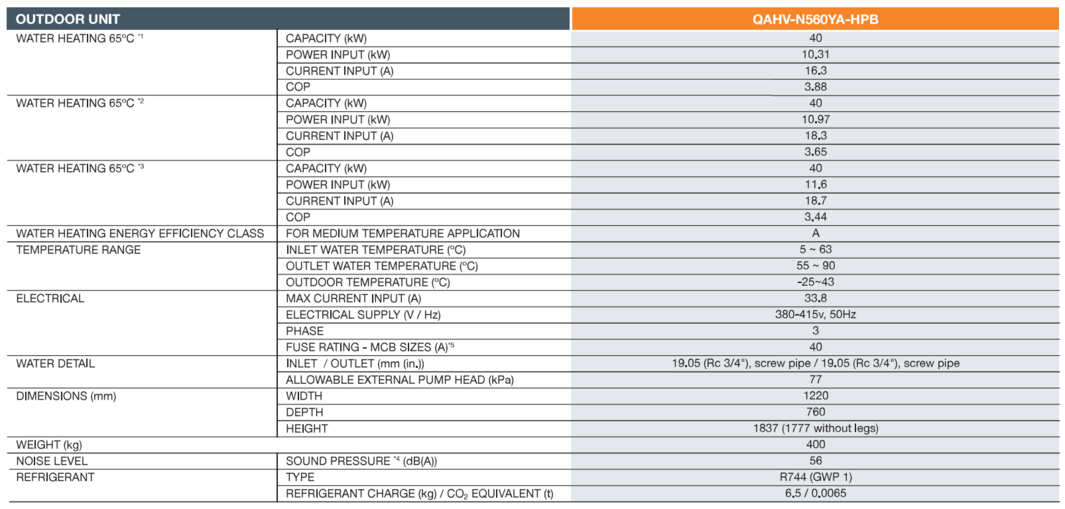
Room Controllers
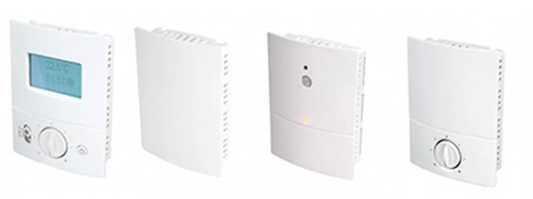
Sontay Smart Room Thermostats with Temperature, CO2, Relative Humidity, PIR and ModBus
Initial requirement is for:
- temperature, humidity and CO2 sensing.
- hard wired
- preferable Modbus RTU / TCP, or BACNET
- existing units that use 0-10v and resistance can be worked with
 Sontay GS-CO2-S
Sontay GS-CO2-S
Suggest SC-S-403000 with:
- temperature, humidity and CO2 sensing.
- PIR sensing
- Modbus RTU or BACnet
- 24v dc
 Sc-x-download.pdf
Sc-x-download.pdf
 Modbus Registers
Modbus Registers
 SC-S Smart Sensor
SC-S Smart Sensor
Domestic Hot Water
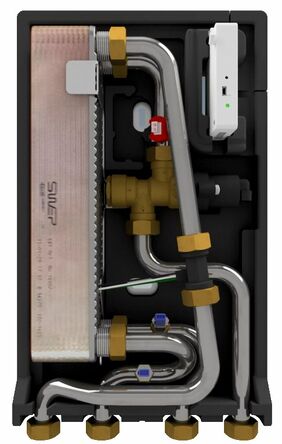
The SLIM HIU (Hydraulic Interface Unit)
Hot water to be provided using a SLIM HIU from Thermal Integration.
- Fully electronic solution with anti-legionella cycle & PC connectivity for set-up and commissioning
- Calibrated sensors for fast DHW temperature control
- Eco / Comfort DHW modes for continuous or intelligent pre-heat
- Compact design - 240mm (W) x 420mm (H) x 90mm (D)
- Fully insulated compartmentalised casing
- Stainless steel pipework
- Open control options
- RS485 interface
- Optional primary pump kit Optional 24V
- DC version
- Optional security case with integral heat meter, landlord security valve and anti-fraud sealing kit.
- From the same family of HIUs as the DATA - has the industries best BESA VWART figures of all time
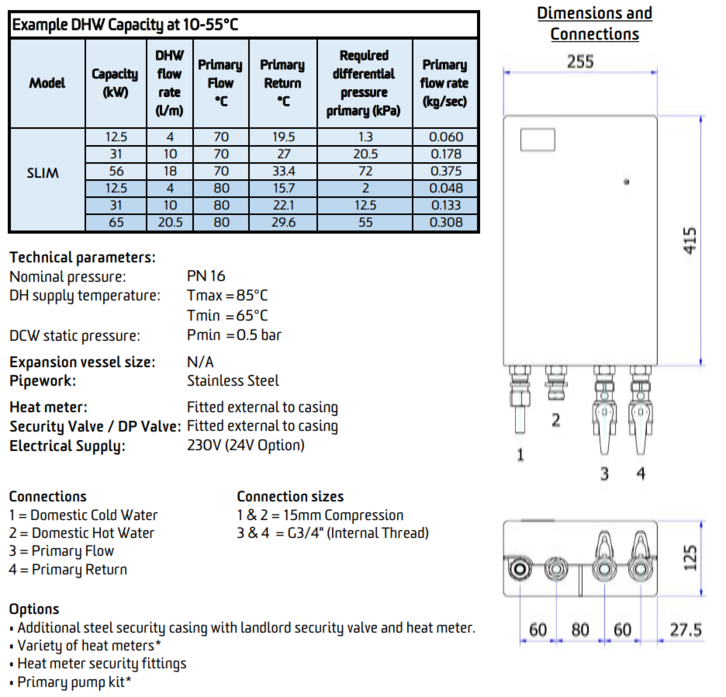
See http://heatweb.co.uk/w/index.php?title=The_SLIM_HIU
Sizing
Bivalent Systems for Heat Networks
The following designs show the impact of a single 40kW heat pump on various numbers of properties. This is unrelated to the SHED, however is shown in order to give the reader a feel for the impact of even a single heat pump on real-world loads.
Each property is 2 bedroom 3 person, and 4kW heating load.
Topping up boilers are included to achieve peak loads.
 Bivalent40kw
Bivalent40kw
Error creating thumbnail: Unable to save thumbnail to destination
This graph shows how the vast majority of load (for 2021) is driven by heat pumps (blue & orange), with boilers (green) used to top up.
Operational Data Policy
This section manages any policies, requirements and plans on data storage, user access, and MQTT permissions.
- Operational data to be logged in real-time
- Recent data points stored in controller memory
- Options to write data logs to hard drive
- Options to write data logs to IPFS file system (encryption policy to discuss)
- Use of both crude and fine grained security settings by user, network, device, data type and key (MQTT ACL file functionality)
- This Wiki project page will detail performance data for as long as SHED is in 'public' mode
- A Private Wiki will run on the LAN with levels of user access control. This will act as:
- the primary user interface,
- storage space for logs locally,
- documentation repository.
- backups of controller software (so new controllers can be cloned)
- VPN access to system
- SSL https certificates on any exposed portals, and on MQTT services.
- None of these core functions to require any licences or software costs (just add internet)
![]() QAHV_6PP_AW_v2
QAHV_6PP_AW_v2![]() QAHV-N560YA-HPB_Service_Manual
QAHV-N560YA-HPB_Service_Manual![]() QAHV-N560YA-HPB_Install_Manual
QAHV-N560YA-HPB_Install_Manual![]() QAHV-N560YA-HPB-PI-SHEET
QAHV-N560YA-HPB-PI-SHEET
 Sontay GS-CO2-S
Sontay GS-CO2-S![]() Sc-x-download.pdf
Sc-x-download.pdf![]() Modbus Registers
Modbus Registers![]() SC-S Smart Sensor
SC-S Smart Sensor